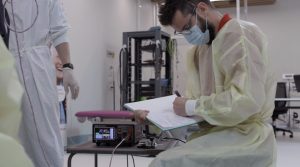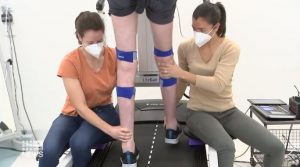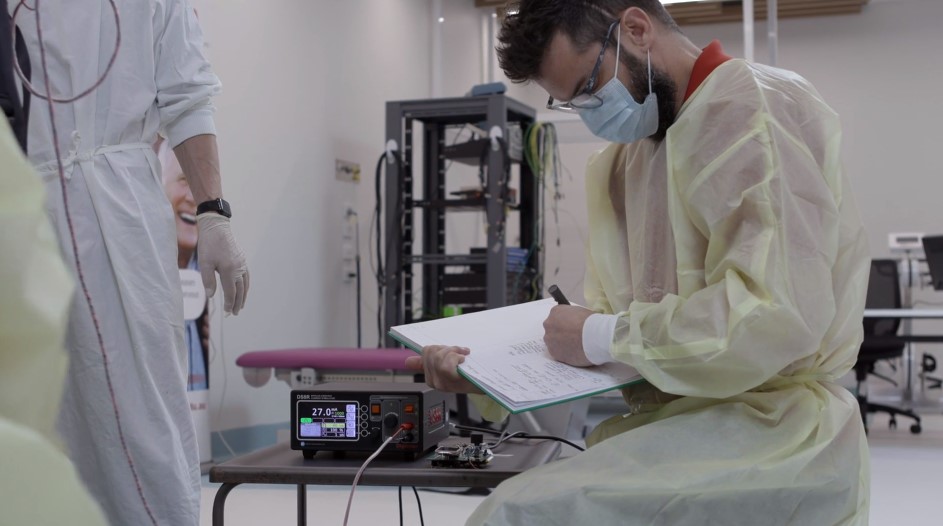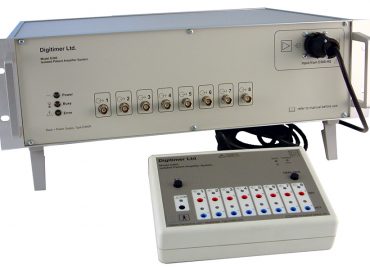Stimulation treatment to help spinal cord injured patients
Trial uses the DS8R to examine the effect of non-invasive electrical stimulation
In a new international clinical trial, researchers and clinicians based at Neuroscience Research Australia (NeuRA), along with collaborators at the Shirley Ryan AbilityLab in Chicago (USA), the Queen Elizabeth National Spinal Injuries Unit in Glasgow (UK) and the Hospital Nacional de Paraplejicos de Toledo (Spain), will examine the effect of transcutaneous spinal cord stimulation on patients with incomplete spinal cord injury. The eWALK study is the first large scale clinical trial intended to examine whether non-invasive stimulation of the remaining nerve fibres within the spinal cord can lead to a partial or full restoration of walking ability. The trial came about as the result of a community initiative led by SpinalCure Australia and is funded by them along with CatWalk Trust NZ.

How the Digitimer DS8R fits into the study
Crucial to this research is the requirement for a suitable electrical stimulator to deliver high voltage constant current stimulation via large surface area electrodes applied to the surface of the skin over the spinal cord. The Digitimer DS8R was selected by these researchers due to its high current capacity (up to 1A) and its ability to reliably deliver precisely controlled, high frequency, biphasic stimuli. The DS8R is not a medical device, but it has been designed for safe use in a human research setting. Digitimer’s expertise within the area of medical electrical stimulator design and manufacturing, means that the DS8R incorporates safety features identical to those required in medically approved equivalents.
When electrical stimulation from the DS8R is coupled with step and walking training in people with chronic paraplegia, it is hoped that this therapy will help to re-wire the neural pathways that have been compromised by the injury.
The potential to open up new non-invasive therapy for those affected by SCI
“Our scientific panel chose to fund this research because neurostimulation holds the most promise out of current research to bring tangible improvement to people with spinal cord injury in the near future,” said SpinalCure Australia CEO, Kathryn Borkovic.
She explains that “Professor Simon Gandevia at NeuRA is one of the world’s leading researchers in the field of human movement disorders, and NeuRA has both an excellent reputation for quality research and is a world-renowned independent not-for-profit research institute.”
Lead researcher, Prof. Simon Gandevia of NeuRA, is aware of several small trials that have suggested such neurostimulation can have a positive effect, but the eWALK study will provide the first multi-centre, large-scale and highly-controlled clinical trial of this novel therapy.
Prof. Gandevia says that “Neurostimulation is like a hearing aid for the spinal cord. The idea is that tailored electrical currents can amplify messages transmitted via surviving neural pathways, thereby enhancing communication between the brain and the body. Neurostimulation restores meaningful movements that would be otherwise impossible. Volunteers in research overseas have even been able to stand and walk. However, until now, researchers have not been able to test this promising technology in a clinical setting.”
The video below from Spinal Cure Australia shows Australian author and SpinalCure ambassador Sam Bloom taking part in initial pilot studies employing the Digitimer DS8R stimulator to deliver non-invasive spinal cord stimulation.
Sam Bloom helps researchers with eWalk trial from SpinalCure on Vimeo.
This exciting new trial has also been picked by Australian news channels including Channel9 Australia, who have featured a story that further explores the theory behind the trial and the potential benefits.

How soon will the results be published?
Initial results are expected in around 18 months, but the researchers hope that the trial will shed light of whether this form of therapy is a viable approach to restoring spinal cord function and walking ability in people who live with the effects of a spinal cord injury.
If you are interested in learning more about the project or making a donation, you can read the full press release from NeuRA here.



